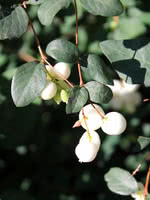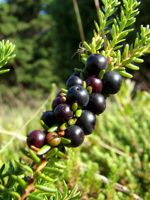Mon-Fri 9am - 5pm Mountain time
Western Snowberry vs Black Crowberry
Symphoricarpos occidentalis
Empetrum nigrum
NOT AVAILABLE THIS SEASON - MIGHT RETURN
CUSTOM GROW
Like the Common Snowberry, the Western Snowberry is a small shrub with pink flowers useful for feeding livestock and preventing erosion. Unlike the common species, however, the Western Snowberry is much more suited to wet conditions, capable of persevering through poor soil drainage and occasional flooding.
After the Snowberry's flowers have bloomed, it produces berries which often last on the plant through winter. These berries are toxic to humans, but livestock and local wildlife love them! Those hoping to attract wildlife to their property can plant Snowberry and expect to see animals foraging on it much later in the year than other plants.
Black Crowberry is a native evergreen shrub that forms low, spreading mats. It has unique foliage that spirals around the stem, and small dark berries, giving it visual appeal. The berries are edible, but can be acidic, so they are not generally eaten fresh. In colder climates, the berries develop a sweet-tart flavor and are often dried or used in desserts, jams, and jellies.
This hardy shrub provides food for birds and mammals, while its flowers attract pollinators such as bees. It also serves as a host plant for certain butterflies and moths. Together, these roles make it a key contributor to the health of tundra and boreal ecosystems.
In Newfoundland and Labrador, the berries are known locally as ‘blackberries’ and are enjoyed in jams, jellies, and traditional baked goods such as buns and puddings. In Scandinavia, they continue to be used in liqueurs, wines, and juices.
Western Snowberry Quick Facts
Black Crowberry Quick Facts
Toxicity: berries are toxic to humans

